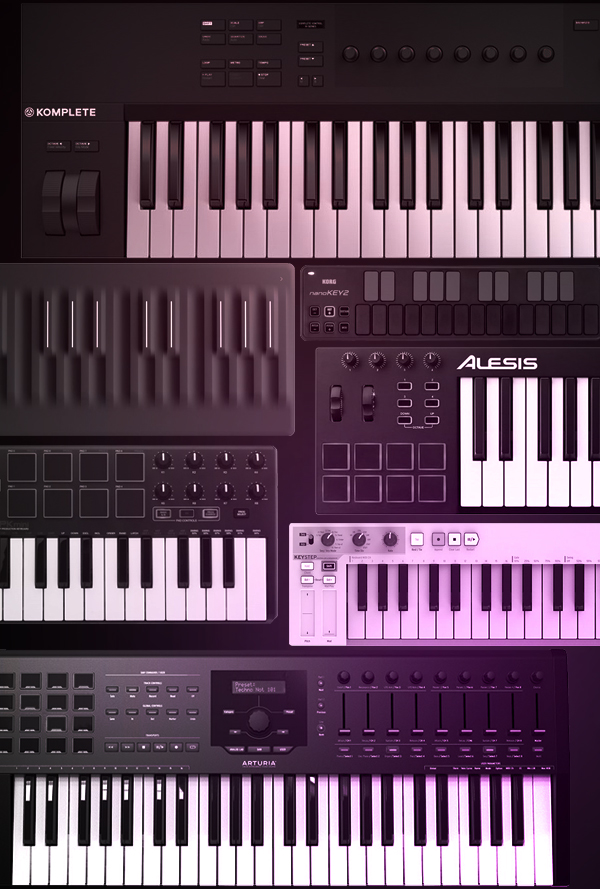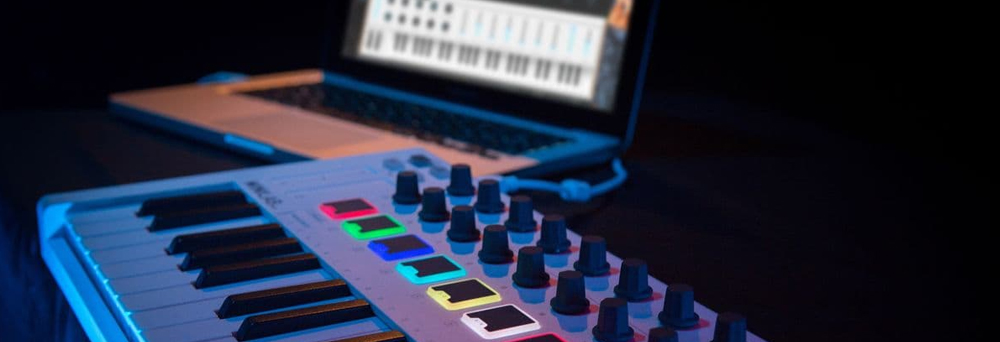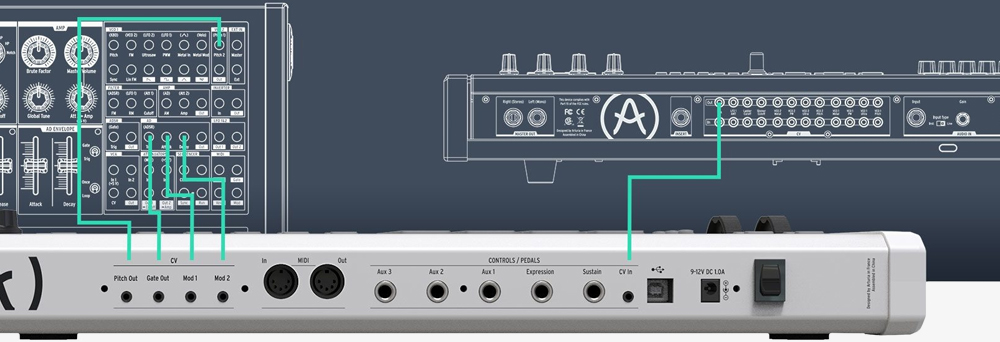
Click here to check out our range of Keyboards Controllers.
Some of the most common questions we receive at Store DJ are variations of "what equipment do I need to make music using digital technology?" Sometimes people are brand new to the world music production, sometimes they're getting back into it after a number of years, perhaps they have a background playing traditional instruments (say, piano or guitar) or maybe they already have experience with a DAW (Digital Audio Workstation) and want to add some extra functionality. Our recommendation for many of these customers is a keyboard controller. Functional and versatile, keyboard controllers offer a bridge between a recognisable instrument layout (piano) and the more unfamiliar world of DAW software. The options for keyboard controllers are pretty massive, with different models offering various performance and integration features. So, we thought we'd run through some of these features to help anyone looking to buy a keyboard controller get the right unit for their purposes, now and in the future.
Firstly, what is a keyboard controller? Often referred to as a "MIDI Controller/Keyboard", it's a keyboard that outputs a MIDI (Musical Instrument Digital Interface) signal to an external sound source. Very simply, MIDI is communications protocol that allows you to connect things that produce and/or control sound, like synths and computers. This way they can all communicate via MIDI messages and something like a (MIDI) keyboard controller, hardware sequencer or DAW software can trigger sound producing devices (if they're capable of accepting MIDI). This is important to note, keyboard controllers are not stand-alone instruments. They have no in-built synthesis engine and can not generate sound by themselves. They do, however, send MIDI (via a 5-pin MIDI cable or USB) to something that does generate sound, such as a virtual instrument on a computer. This is their primary function, to "trigger" and control an instrument, be it virtual or physical hardware (such as a sampler or rackmounted synth).

You may have software synths which can be triggered using a QWERTY computer keyboard in a DAW like Ableton. This is a perfectly fine way of "playing" these software instruments but it's certainly not optimal, especially if you want to play anything more complex. This is where a keyboard controller comes in, not only giving you the ability to play a virtual instrument in a more traditional fashion, but often making it possible to adjust and modulate the software's virtual parameters from the front panel of the hardware controller.
Once you've determined that a keyboard controller might be useful to you, it helps to think about certain features that you may or may not need. Size is an obvious starting point. Keyboards controllers come in a big range of shapes and sizes, from full-sized 88-key options down to the laptop-bag friendly Korg nanoKey. It's good to think about your proficiency at playing piano/keyboard, how you might use the controller and how much space you have. If you're a beginner, with a small studio space, who doesn't perform live you might only need a 25 key controller. However an established player, who performs live may want the flexibility of a 49, 61 or 88 key model. Regardless of what model you choose, keyboard controllers have octave "Up/Down" buttons to move the accessible key range up or down across the physical keybed.

The M-Audio Code 61, Native Intruments Komplete Kontrol A25 and Korg nanoKey2 (above) show how more expanded control functions often require a larger keyboard.
Other major features address not only performance, but also how the controller interacts with a DAW (or whatever it's controlling) for more production based functions. Considering which of these are important to you is often based on workflow or your personal playing style. Controllers regularly incorporate things like wheels or ribbon strips to manipulate modulation and pitch, which are more performative elements. While things like encoders, knobs and sliders, while also great for performance, can be just as helpful for mixing purposes, or when assigned to the parameters of a synthesizer when formulating sounds.
Adding a tactile, hands-on experience to a virtual instrument is one of the major benefits of having sliders and knobs/encoders on a controller and often makes the process of creating sounds more intuitive and enjoyable. Pads can also be a great addition as well. Programming drums using MPC-style pads is very popular, remember you can also "play" your drums using the keys as well. The larger the keyboard, the more real estate available to accommodate these features, but it's worth noting that there are some clever designs that pack a lot into a smaller, more affordable form-factor as well.

The Akai MPK Mini (Left) gives you MPC style pads and 8 knobs, while the APC Key (Right) features a grid of buttons, that represent Ableton's clip view for intuitive clip launching, both include a lot of functionality in a small space.
Finally, lets discuss integration. Although some keyboard controllers are positioned as being designed for a specific pieces of software, they all transmit MIDI information and will trigger any DAW. You may see something like the Novation LaunchKey or SL MKIII, which is designed for optimal Ableton Live integration, but this is a great controller and will work fine with any DAW. Certain features (like the dedicated clip launch buttons) can simply be used for other functions.
Most DAW software will have pre-sets for certain controller models, which once selected, will map set control functions in the DAW to whatever hardware controls (knobs, pads, faders) your keyboard has. In the reverse, we're now seeing some keyboard controllers, like the Arturia KeyLab MK2 range, with selectable DAW presets that will assign the functionality and transport controls based on the virtual layout of the selected DAW. It is usually possible to customise the mapping of functions on your controller inside your chosen software.

The coloured buttons on the Launchkey can be used to launch clips in Ableton Live, or as regular MIDI triggers.
Hardware I/O is also something to be considered. Not all "MIDI Keyboards" actually have 5-pin MIDI ins-and-outs, which is worth thinking about as you may have a desire to integrate hardware into your setup at sometime in the future. Having a keyboard with MIDI Out would allow you to control desktop style synths, or some semi modular units without a computer, using only the MIDI I/O. Synths in this form often don't include built-in keyboards and sometimes lack any way to trigger sounds internally. Some keyboard controllers are even integrating CV/Gate connectivity now, so you can use them to trigger modular and semi-modular units that don't receive MIDI. Keep an eye our for keyboards that also feature built in arpeggiators and sequencers as well, for extra functionality.

The Arturia KeyLab, KeyStep and Novation SK MKIII feature CV outs as well as MIDI and so can be used to control things like Modular and Semi-Modular synths.
Overall there a number to things to consider when looking at keyboard controllers. Space and intended use might determine the key size you choose, whether you choose a keyboard with pads, faders or encoders could be based on your workflow. If you want to incorporate hardware into your setup you might want something with MIDI or CV connections. It's also worth noting that many controllers come with a "lite" version of a DAW and often a small selection of plug-ins. They can be a great way to get started making music, even if you have limited experience and no other equipment.
For an extensive range of keyboard controllers or if you have any questions about anything related, come down and see us at Store DJ.
Click here to check out our range of Keyboard Controllers.